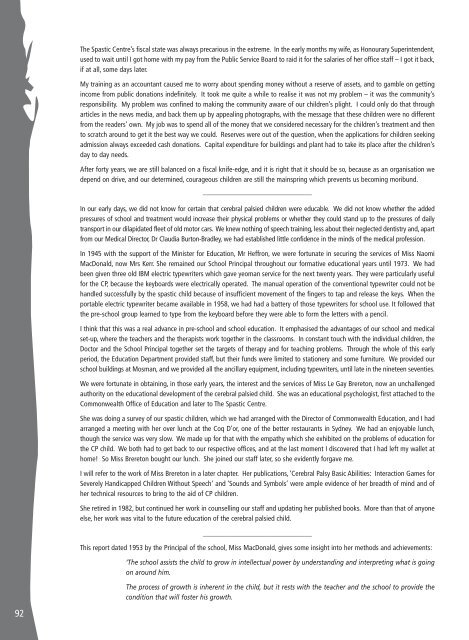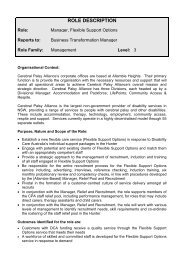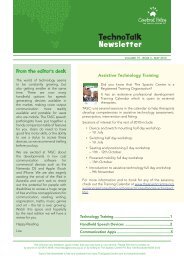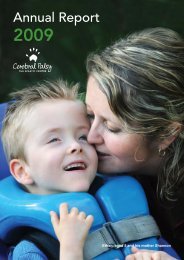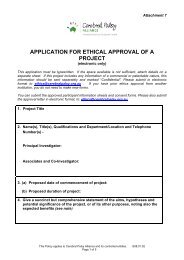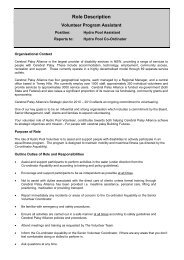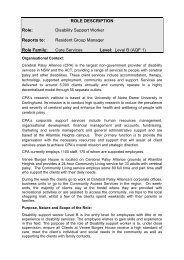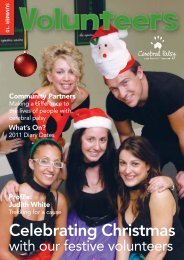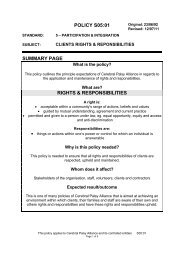'Nothing is impossible' - Part 2, chapter 4-8 - The Spastic Centre
'Nothing is impossible' - Part 2, chapter 4-8 - The Spastic Centre
'Nothing is impossible' - Part 2, chapter 4-8 - The Spastic Centre
Create successful ePaper yourself
Turn your PDF publications into a flip-book with our unique Google optimized e-Paper software.
<strong>The</strong> <strong>Spastic</strong> <strong>Centre</strong>’s f<strong>is</strong>cal state was always precarious in the extreme. In the early months my wife, as Honourary Superintendent,<br />
used to wait until I got home with my pay from the Public Service Board to raid it for the salaries of her office staff – I got it back,<br />
if at all, some days later.<br />
My training as an accountant caused me to worry about spending money without a reserve of assets, and to gamble on getting<br />
income from public donations indefinitely. It took me quite a while to real<strong>is</strong>e it was not my problem – it was the community’s<br />
responsibility. My problem was confined to making the community aware of our children’s plight. I could only do that through<br />
articles in the news media, and back them up by appealing photographs, with the message that these children were no different<br />
from the readers’ own. My job was to spend all of the money that we considered necessary for the children’s treatment and then<br />
to scratch around to get it the best way we could. Reserves were out of the question, when the applications for children seeking<br />
adm<strong>is</strong>sion always exceeded cash donations. Capital expenditure for buildings and plant had to take its place after the children’s<br />
day to day needs.<br />
After forty years, we are still balanced on a f<strong>is</strong>cal knife-edge, and it <strong>is</strong> right that it should be so, because as an organ<strong>is</strong>ation we<br />
depend on drive, and our determined, courageous children are still the mainspring which prevents us becoming moribund.<br />
______________________________<br />
In our early days, we did not know for certain that cerebral palsied children were educable. We did not know whether the added<br />
pressures of school and treatment would increase their physical problems or whether they could stand up to the pressures of daily<br />
transport in our dilapidated fleet of old motor cars. We knew nothing of speech training, less about their neglected dent<strong>is</strong>try and, apart<br />
from our Medical Director, Dr Claudia Burton-Bradley, we had establ<strong>is</strong>hed little confidence in the minds of the medical profession.<br />
In 1945 with the support of the Min<strong>is</strong>ter for Education, Mr Heffron, we were fortunate in securing the services of M<strong>is</strong>s Naomi<br />
MacDonald, now Mrs Kerr. She remained our School Principal throughout our formative educational years until 1973. We had<br />
been given three old IBM electric typewriters which gave yeoman service for the next twenty years. <strong>The</strong>y were particularly useful<br />
for the CP, because the keyboards were electrically operated. <strong>The</strong> manual operation of the conventional typewriter could not be<br />
handled successfully by the spastic child because of insufficient movement of the fingers to tap and release the keys. When the<br />
portable electric typewriter became available in 1958, we had had a battery of those typewriters for school use. It followed that<br />
the pre-school group learned to type from the keyboard before they were able to form the letters with a pencil.<br />
I think that th<strong>is</strong> was a real advance in pre-school and school education. It emphas<strong>is</strong>ed the advantages of our school and medical<br />
set-up, where the teachers and the therap<strong>is</strong>ts work together in the classrooms. In constant touch with the individual children, the<br />
Doctor and the School Principal together set the targets of therapy and for teaching problems. Through the whole of th<strong>is</strong> early<br />
period, the Education Department provided staff, but their funds were limited to stationery and some furniture. We provided our<br />
school buildings at Mosman, and we provided all the ancillary equipment, including typewriters, until late in the nineteen seventies.<br />
We were fortunate in obtaining, in those early years, the interest and the services of M<strong>is</strong>s Le Gay Brereton, now an unchallenged<br />
authority on the educational development of the cerebral palsied child. She was an educational psycholog<strong>is</strong>t, first attached to the<br />
Commonwealth Office of Education and later to <strong>The</strong> <strong>Spastic</strong> <strong>Centre</strong>.<br />
She was doing a survey of our spastic children, which we had arranged with the Director of Commonwealth Education, and I had<br />
arranged a meeting with her over lunch at the Coq D’or, one of the better restaurants in Sydney. We had an enjoyable lunch,<br />
though the service was very slow. We made up for that with the empathy which she exhibited on the problems of education for<br />
the CP child. We both had to get back to our respective offices, and at the last moment I d<strong>is</strong>covered that I had left my wallet at<br />
home! So M<strong>is</strong>s Brereton bought our lunch. She joined our staff later, so she evidently forgave me.<br />
I will refer to the work of M<strong>is</strong>s Brereton in a later <strong>chapter</strong>. Her publications, ‘Cerebral Palsy Basic Abilities: Interaction Games for<br />
Severely Handicapped Children Without Speech’ and ‘Sounds and Symbols’ were ample evidence of her breadth of mind and of<br />
her technical resources to bring to the aid of CP children.<br />
She retired in 1982, but continued her work in counselling our staff and updating her publ<strong>is</strong>hed books. More than that of anyone<br />
else, her work was vital to the future education of the cerebral palsied child.<br />
______________________________<br />
Th<strong>is</strong> report dated 1953 by the Principal of the school, M<strong>is</strong>s MacDonald, gives some insight into her methods and achievements:<br />
‘<strong>The</strong> school ass<strong>is</strong>ts the child to grow in intellectual power by understanding and interpreting what <strong>is</strong> going<br />
on around him.<br />
<strong>The</strong> process of growth <strong>is</strong> inherent in the child, but it rests with the teacher and the school to provide the<br />
condition that will foster h<strong>is</strong> growth.<br />
92


